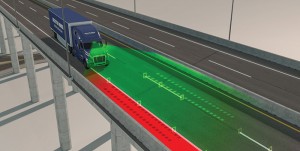Mandating stability control and safety systems for heavy trucks began several years ago with the National Highway Traffic Safety Administration (NHTSA) test analysis, which revealed that a large percentage of heavy truck crashes are rollover-related and can be mitigated by stability control interventions. During that period, braking system suppliers began testing new braking and stability control systems and rolled out products in advance of the mandate, which they have been enhancing ever since.
Where it all began
Advanced driver assistance systems (ADAS) have been in development since the early 1970s. It started with antilock braking systems (ABS), followed by electronic stability control (ESC) and then collision mitigation systems (CMS), lane departure warning (LDW), blind spot and video analytics.
“ABS, ESC, CMS and video analytics are all tightly integrated with each other so drivers sense a highly effective, single system is in operation to help ensure truck stability and avoid crashes,” said Matthew Stevenson, president and general manager of Meritor WABCO. “Many of the required sensors, electronic control units and actuators are used by all three systems. Each control system has a detailed product specification that contains a rigorous set of laboratory and vehicle performance standards. ABS and stability control also have minimum performance requirements set by NHTSA as they are or will become regulated technologies. The technologies are tested individually to ensure their product specifications are achieved and with one another to verify a high level of integrated vehicle performance.
“Once product specifications are achieved, systems are field tested in actual on-road usage to verify a performance will meet and exceed the expectations of our end user customers,” Stevenson continued. “With more than 100,000 OnGuard systems and more than 9,000,000 SmartTrac ABS systems currently on North American roads, Meritor WABCO has the benefit of direct fleet and driver feedback. This feedback is integrated into regular upgrades of our systems.”
Building an integrated system
Fred Andersky, director of customer solutions—controls and of government and industry affairs for Bendix Commercial Vehicle Systems LLC, spoke about the company’s development and testing: “Each technology in the portfolio of Bendix Wingman driver assistance systems goes through a rigorous development and testing procedure that includes bench, lab and weathering testing of individual components; track testing, including winter tests in Houghton, Mich.; and field testing of systems—including mileage accumulations in real highway and driver conditions. They also undergo OEM testing and evaluation for production certification, along with fleet trials for operational and driver feedback. Bendix engineers continue product evaluations in the field as well based on our warranty experience.”
“The Detroit Assurance suite of safety systems was designed to protect drivers and your business by delivering a new level of on-road control and protection in Freightliner Cascadia and Cascadia Evolution trucks,” explained Kelly Gedert, powertrain marketing manager for Daimler Trucks North America (DTNA). “The suite fully integrates with your Detroit engine and transmission, as well as your truck’s braking systems and dashboard, to enhance driver safety by mitigating collisions.”
Detroit’s Assurance line includes both a standard radar system and an optional camera system. The radar system first uses two cab-mounted modules to monitor and interpret the movement of other vehicles. The radar can sense when another vehicle is too close, which then activates the Active Brake Assist (ABA) feature to mitigate collisions.
“Active Brake Assist has three stages of collision mitigation when a potential collision is detected,” Gedert elaborated. “First, the radio mutes and an audible warning sounds accompanied by an in-dash notification for the driver. Next, the system will initiate partial braking to physically warn the driver. Finally, if there is still no response from the driver, the system will enact full braking to slow the truck. The radar system also enables the Adaptive Cruise Control [ACC] feature that automatically adjusts the vehicle’s cruise control speed to maintain a safe following distance in changing traffic conditions. The following distance can be set by the driver to meet his specific needs for the job at hand.”
Detroit Assurance equipment includes bumper-mounted radar that detects objects ahead of the vehicle; and The Video Radar Detection Unit (VRDU) located in the cab, which commands the ABS, transmission and other engine computers. The optional camera system tracks the truck’s position within the lane. The camera system faces the road. It never faces or records the driver.
Detroit Assurance’s optional camera system enables the Lane Departure Warning (LDW) feature. The windshield-mounted camera always faces the road (never the driver) and tracks the truck’s position within the lane. If the truck starts to cross outside of its driving lane without its turning signal on, the radio will mute and an audible warning will sound to alert the driver. Gedert explained that the audible warning will come from the truck speaker on the side of the road where the line was crossed. “For example,” she said, “if the left lane is crossed, then the left speaker broadcasts the audible warning.”
It is important to note that the LDW option can only be active at speeds above 37 MPH.
Integrated system benefits
 “An integrated suite of safety technologies helps fleets, drivers and technicians in a number of ways,” said Andersky of Bendix. “Today, a fleet can have multiple independent systems from different manufacturers such as collision mitigation technology from one and lane departure warning from another. While these systems typically work well for individual situations, they can be a source of driver distraction in combined situations. For example, if a truck is going out of its lane while a car in front of it has abruptly stopped, the driver could get two alerts—one for lane departure warning and one for the impending collision. These two alerts at the same time could create a momentary distraction as the driver tries to comprehend both alerts. It may be only milliseconds, but that could be the difference between a quick reaction by the driver and a crash. An integrated system such as Bendix Wingman Fusion gives the driver the most important alert first, helping focus their attention on the most critical situation—in our example, the impending collision over the lane departure.”
“An integrated suite of safety technologies helps fleets, drivers and technicians in a number of ways,” said Andersky of Bendix. “Today, a fleet can have multiple independent systems from different manufacturers such as collision mitigation technology from one and lane departure warning from another. While these systems typically work well for individual situations, they can be a source of driver distraction in combined situations. For example, if a truck is going out of its lane while a car in front of it has abruptly stopped, the driver could get two alerts—one for lane departure warning and one for the impending collision. These two alerts at the same time could create a momentary distraction as the driver tries to comprehend both alerts. It may be only milliseconds, but that could be the difference between a quick reaction by the driver and a crash. An integrated system such as Bendix Wingman Fusion gives the driver the most important alert first, helping focus their attention on the most critical situation—in our example, the impending collision over the lane departure.”
Andersky added that another benefit is that an integrated system allows the driver to get information through the dash, instead of through multiple individual alert devices. This helps decrease any potential distraction and enables the technology to aid the driver’s reactions and responses while on the road. In addition, with an integrated suite of technologies, driver training is focused on one system, as opposed to multiple systems on the vehicle.
“This focus helps ensure the driver understands the system, how it will respond, and how to enhance their own driving as a result,” he explained. “Here’s a great parallel: When I was younger I used to have a stereo system with multiple components from different manufacturers; each had different operating instructions. These days, I am a lot happier and enjoy my music a lot more thanks to my compact system that has everything integrated in one package. I think drivers will feel the same regarding an integrated safety system.”














